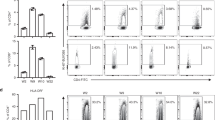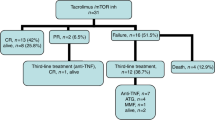Abstract
The 4-aminoquinolines, chloroquine and hydroxychloroquine, can suppress chronic graft-versus-host disease (GVHD) following blood and marrow transplantation (BMT) in mice and humans, respectively. We hypothesized that chloroquine in combination with tacrolimus and the rapamycin derivative SDZ-RAD can synergistically suppress T cell responses and antigen-presenting cell (APC) function in vitro. We used the APC-dependent C57BL/6 anti-BALB.B T cell response and APC-independent anti-CD3ε antibody-induced response to evaluate the role of synergism between chloroquine and tacrolimus or SDZ-RAD on each component of a T cell response to minor histocompatibility antigens. We found that chloroquine with tacrolimus had a greater synergistic suppression of APC-dependent compared to the APC-independent T cell responses, with a combination index (CIx) for 50% inhibition by mean effect analysis of 0.16 and 0.50, respectively (a lower number indicates greater suppression). By contrast, chloroquine with SDZ-RAD had a similar CIx between the two responsed 0.50 vs0.45) suggesting only T cell suppression. Synergy between chloroquine and SDZ-RAD involved a direct effect on T cell cytokine production, whereas synergism between chloroquine and tacrolimus was due to an effect on both T cells and APCs. We conclude that the renal-sparing 4-aminoquinolines may be used syneristically with immunosuppressive drugs currently used for BMT.
This is a preview of subscription content, access via your institution
Access options
Subscribe to this journal
Receive 12 print issues and online access
$259.00 per year
only $21.58 per issue
Buy this article
- Purchase on Springer Link
- Instant access to full article PDF
Prices may be subject to local taxes which are calculated during checkout




Similar content being viewed by others
References
Jacoboson P, Uberti J, Davis W, Ratanatharathorn V . Tacrolimus: a new agent for the prevention of graft-versus-host disease in hematopoietic stem cell transplantation Bone Marrow Transplant 1998 22: 217 225
Dumont FJ, Melino MR, Staruch MJ et al. The immunosuppressive macrolides FK-506 and rapamycin act as reciprocal antagonists in murine T cells J Immunol 1990 144: 1418 1424
Dumont FJ, Staruch MJ, Koprak SL et al. Distinct mechanisms of suppression of murine T cell activation by the related macrolides FK-506 and rapamycin Immunology 1990 144: 251 258
Hess DA, Bird IA, Almawi WY, Rieder MJ . The hydroxylamine of sulfamethoxazole synergizes with FK506 and cyclosporin A, inhibiting T-cell proliferation J Pharmacol Exp Ther 1997 281: 540 548
Blazar BR, Taylor PA, Sehgal SN, Vallera DA . Rapamycin, a potent inhibitor of T-cell function, prevents graft rejection in murine recipients of allogeneic T-cell-depleted donor marrow Blood 1994 83: 600 609
Fung JJ, Todo S, Tzakis A et al. Conversion of liver allograft recipients from cyclosporin to FK506-based immunosuppression: benefits and pitfalls Transplant Proc 1991 23: 14 21
Blazar BR, Taylor PA, Sehgal SN, Vallera DA . Rapamycin prolongs survival of murine recipients of fully allogeneic donor grafts when administrated during the graft-versus-host disease process Ann NY Acad Sci 1993 685: 73 85
Schuurman HJ, Cottens S, Fuchs S et al. SDZ RAD, a new rapamycin derivative, synergism with cyclosporin Transplantation 1997 64: 32 35
Schuler W, Sedrani R, Cottens S et al. SDZ RAD, a new rapamycin derivative, pharmacological properties in vitro and in vivo Transplantation 1997 64: 36 42
Schuurman HJ, Schuler W, Ringers J, Jonker M . The macrolide SDZ RAD is efficacious in a nonhuman primate model of allotransplantation Transplant Proc 1998 30: 2198 2199
Bohler T, Waiser J, Budde K et al. The in vivo effect of rapamycin derivative SDZ RAD on lymphocyte proliferation Transplant Proc 1998 30: 2195 2197
Schultz KR, Bader S, Nelson D et al. Immune suppression by lysosomotropic amines and cyclosporine on T-cell responses to minor and major histocompatibility antigens Transplantation 1997 64: 1056 1065
Schultz KR, Bader S, Paquet J, Li W . Chloroquine treatment affects T-cell priming to minor histocompatibility antigens and graft-versus-host disease Blood 1995 86: 4344 4352
Nagai F, Ushiyama K, Kano I et al. Inhibition of calmodulin stimulation of phosphodiesterase and Ca2+, Mg2+-ATPase activities and shape change of erythrocyte ghosts by chloroquine Biochem Pharmacol 1987 36: 3433 3437
Schultz KR, Nelson D, Bader S . Synergy between lysosomotropic amines and cyclosporin A on human T cell responses to an exogenous protein antigen, tetanus toxoid Bone Marrow Transplant 1996 18: 625 631
Dukmans BA, Borne BE, Landewe RB et al. Chloroquine combined with cyclosporine in rheumatoid arthritis: more than the addition of 2 drugs alone J Rheumatol 1996 23: (Suppl. 44) 61 63
Goldman FD, Gilman AL, Hollenback C et al. Hydroxychloroquine inhibits calcium signals in T cells: a new mechanism to explain its immunomodulatory properties Blood 2000 95: 3460 3466
Gilman AL, Chan KW, Mogul A et al. Hydroxychloroquine for the treatment of chronic graft-versus-host disease Biol Blood Marrow Transplant 2000 6: 327 334
Yang X, Gieni RS, Mosmann TR, HayGlass KT . Chemically modified antigen preferentially elicits induction of Th1-like cytokine synthesis patterns in vivo J Exp Med 1993 178: 349 353
Gieni RS, Li Y, HayGlass KT . Comparison of 3H-thymidine incorporation with MTT and MTS bioassays for human and murine IL-2 and IL-4 analysis: tetrazolium assays provide markedly enhanced sensitivity J Immunol Meth 1995 187: 85 93
Lam GKY . The differential aspects of the linear isobole in the study of combined action of agents Bull Mathe Biol 1993 55: 295 313
Berenbaum MC . Synergy, additivism, and antagonism in immunosuppression: a critical review Clin Exp Immunol 1977 28: 1 18
Chou T-C . Derivation and properties of Michaelis–Menten type and Hill type equations for reference ligands J Theor Biol 1976 59: 253 276
Kahan BD, Gibbons S, Tejpal N et al. Synergistic interactions of cyclosporine and rapamycin to inhibit immune performances of normal human peripheral blood lymphocytes in vitro Transplantation 1991 51: 232 239
Kahan BD, Chou T, Tejpal N et al. Synergistic effects of cyclosporin analogs-A, D, G, Imm-125- with rapamycin and/or brequinar Transplant Proc 1994 26: 3021 3024
Powell JD, Lerner CG, Schwartz RH . Inhibition of cell cycle progression by rapamycin induces T cell clonal anergy even in the presence of costimulation J Immunol 1999 162: 2772 2784
Vogelsang GB . How I treat chronic GVHD Blood 2001 97: 1196 1201
Quesniaux VFJ, Wehrli S, Steiner C et al. The immunosuppressant rapamycin blocks in vitro responses to hematopoietic cytokines and inhibits recovering but not steady-state hematopoiesis in vivo Blood 1994 84: 1543 1552
Blazar BR, Taylor PA, Panoskaltsis-Mortari A, Vallera DA . Rapamycin inhibits the generation of graft-versus-host disease- and graft-versus-leukemia-causing T cells by interfering with the production of Th1 or Th1 cytotoxic cytokines J Immunol 1998 160: 5355 5365
Author information
Authors and Affiliations
Rights and permissions
About this article
Cite this article
Hsiao, CC., Su, W., Forooghian, F. et al. Evaluation for synergistic suppression of T cell responses to minor histocompatibility antigens by chloroquine in combination with tacrolimus and a rapamycin derivative, SDZ-RAD. Bone Marrow Transplant 30, 905–913 (2002). https://doi.org/10.1038/sj.bmt.1703727
Received:
Accepted:
Published:
Issue Date:
DOI: https://doi.org/10.1038/sj.bmt.1703727
Keywords
This article is cited by
-
Autophagy and haematopoietic stem cell transplantation
Immunology & Cell Biology (2015)



